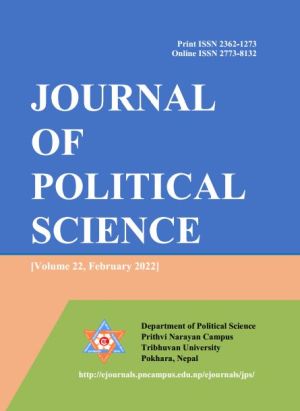Models of Federalism and Nepal's Practices
DOI:
https://doi.org/10.3126/jps.v22i1.43038Keywords:
Federation, governance, power, decentralization, devolutionAbstract
Many countries at recent are well governing under federalism; meanwhile, a few of the countries are struggling hard to sustain their federal form of government. This research purposes to explore federalism, federal forms, models of federalism that are being practiced in different countries, including the issues, challenges, practices and their relevance of federalism in Nepal. I investigated the significance of federalism in the paper through an intensive analysis of the positive aspects and drawbacks of federalism. For the research, various reference books, articles, and reports are taken under consideration whereas secondary data is supported by primary data. It is qualitative and descriptive research. Federalism, a structure of government combining a general government with regional governments, is roughly found in over 25 countries in the world. Federalism has a federal/central government at the top while the regional governments such as provincial, state, territorial, cantonal, or other sub-unit governments are below the central government. These different tiers of government function cordially in various sectors of development, planning and policy-making of the state and its parts. In the paper, going through the study of models of federalism, the present context of countries exercising federalism and the strength and weakness of the federal model, we can conclude the significance of federalism, its necessity, and ways of achieving it. One shall predict the future of federalism passing through this paper.
Downloads
Downloads
Published
How to Cite
Issue
Section
License
Copyright (c) 2022 Department of Political Science, Prithvi Narayan Campus

This work is licensed under a Creative Commons Attribution-ShareAlike 4.0 International License.




